Motifs
Above
all, the
extraordinary thing about Delft/Dutch tiles is that every single faience
is a small complete work of art in itself. Handpainted by artists, each
tile is - although mass produced - different. Moreover, the great variety of
themes and motifs used by the painters to decorate tiles emphasizes this
uniqueness.
For
more pictures of tiles under each motif,
please click the link.
For a
quick search click the following links:
<flower
pots or vases> <flowers>
<fruit dishes and fruits> <still
life designs> <landscapes>
<biblical
scenes> <ships>
<fish>
<children's games> <angels>
<soldiers> <horsemen>
<everyday situations or
professional occupations> <shepherds>
<Chinese motifs>
<animals> <birds>
<insects> <sea
creatures or sea
monsters> <mythological scenes>
<ornamental designs> <cartouche
and inanimate
designs> <pillars and festoons>
<borders,
plinths or friezes>
Especially
„flower pots or vases“
("bloempotten"), namely with the characteristic triple bloom,
have often been used to decorate tiles since 1570.
|

|
The earliest flower pots
or vases (1570 - 1630) were multicoloured
(polychrome); from 1620
on they were mostly painted in blue (the "Delft blue") and later
(18th and 19th century) also in purple (Fig.:
flower pot in a large threefold circle; purple; corner motif: modified
fretwork; Utrecht or Harlingen since 1800; 13,0 x 13,0 x 0,7 cm).
|
The
motifs of the early 17th century were usually painted in a two-coloured
diamond-shaped Moorish square. After 1620 they were surrounded either by a
baluster or an accolade. From 1630 on you also find sometimes the jagged diamond. The
typical corner motifs of the early period were the quarter rosette and the Moorish
patterns, both painted in the reserve technique; the French lily (after 1610); the (large)
ox-head, and the fretwork patterns (both after 1620). On tiles manufactured in the
late 18th and in the 19th
century the central motifs were mostly painted in three rings with modified
fretwork corner motifs (see
fig. above).
Back
to top
Just as typical
are
flowers, which appeared about 1620.
Illustrations in plant, herb and flower
books, which reflected an increasing interest in
nature at that time, served as models for the tile painters.
| This is the reason, that
flowers, e.g the crown imperial, the narcissus or all kind of tulips,
are painted in a very naturalistic way (Fig.: flower;
polychrome; corner
motif: polychrome lily; probably Gouda, 1620 - 1640; 13,0 x 13,0 x
1,2 cm). During
the 18th and 19th century, however, stylized flowers were
predominant, especially the well known so called Frisian or strewed
flower. |
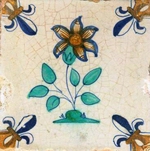
|
|
Fruits
belong to the early motifs, too, already painted since 1580, and furthermore fruit
dishes, in which the painting started in 1600. From the mid-17th
centuy on fruits, and also flowers or other objekts, were now and then part of a
still
life.
Back
to top
Landscapes
are a second typical design.
|

|
The production of tiles
with landscape motifs increased during the 2nd half of the 17th century. Earlier
landscape tiles, however, which were painted begining in 1590, are rare.
These tiles are often polychrome. After 1650 most landscape tile were painted in blue; from the 18th century to the late 19th
century purple ("manganese") was also quite popular.
|
| Many of these tiles are
decorated with rivers or channels; you often see several sailing ships
in the background (Fig.:
windmill in a small double circle; blue; corner motif: spider; Makkum, 1860 -
1900;
12,8 x 12,8 x 0,7 cm; for more examples from the 18th c. see the links "Fascination" and "Corner
motifs"). Castles or
farmsteads, houses or huts, wells, bridges, dovecots, swans, trees and, of course,
windmills are usually shown in the centre.
While the early motifs typically are painted inside
an Italian circle band or the Moorish square, each with corner
motifs in reserve technique (e.g. quarter rosette or palmette), later in
baluster and accolade borders (starting in 1620), the central
motifs from the mid-17th to the early 18th century are quite small, with
no circles and sometimes even
without corner motifs.
| The well-known motifs of the 18th century
are mostly surrounded by large double circles and octagons, and in the 19th
century usually by smaller double circles. Typical corner motifs are now
the ox-head, the spider or the
carnation, but also the quarter rosette, especially if
the motif is painted in an octagon
border (Fig.:
riverside with farmer ferrying his livestock across the river,
surrounded by an octagon;
blue and purple; corner motif: carnation; Rotterdam, 1740
- 1780; 12,8 x 12,8 x 0,8 cm).
|

|
Back
to top
|
|

|
Biblical
tiles are the
third type of tiles which were very popular. Believe
it or not, starting in 1640 (polychrome tiles from the early 17th
century are, however, quite rare) more or less 600 different scenes
from the Old and New Testaments were painted on tiles (Fig.: "The circumcision of Jesus",
Luke II.21.; blue; corner
motif: spider;
Utrecht, 1st half of the 18th c.; 13,0 x 13,0 x 0,7 cm).
|
|
|
Production took place, starting
in the late 17th century, in the well-known factories in Haarlem, Rotterdam, Amsterdam, Utrecht, Harlingen,
Makkum and Bolsward, which reached its height in the 18th
century. Tiles with biblical scenes were used predominately on tiled stoves and fireplaces. Particularly these tiles were
very popular in the 18th
century among the wealthy rural population.
The
production of biblical tiles almost stopped in
the 19th century. Only in Utrecht,
Makkum and Harlingen did they continue to be manufactured (and are still
made today).
The
typical biblical tile is painted in blue, and later also in purple. In the
17th century the central motif is often surrounded by a large double circle; corner
motifs are the ox-head and the spider. Illustrations without a circle, most of
which were produced between the late 17th century and mid-18th century, nearly always
have the spider as a corner motif (see
fig. above).
In
the 18th century most of the blue and purple painted biblical scenes are again surrounded by a large double
circle, with ox-heads as corner
motifs.
| In the first quarter of the
18th
century you find for the first time the biblical reference for the scene,
written below the central motif (Fig.:
"The three wise men out of the East are directed to
Christ by a star", Matthew II.9.,10.; in large double circle; purple; corner
motif: ox-head; 18th c.; 13,0 x 13,0 x 0,7 cm). |
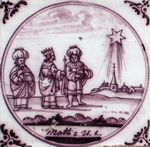
|
|
The tiles of this period with carnation corner motifs, which are particularly
finely painted, are remarkable.
Starting from the mid-18th century the central
motifs were painted in octagonal borders with quarter rosettes, feathers and
modified leaves as corner motifs. From the end of the 18th century on, the scenes
were again painted in a square, now often with borders of striped leaves. In
the 19th century the large double-circle border around the central motif and the ox-head corner motif
were prevalent.
Now most of the tiles included a biblical reference.
Back
to top
But that's not all: The
painters used an abundance of further themes,
showing everyday life, as well as land and sea creatures,
usually inspired by well-known paintings, wood and copper engravings, and etchings.
|
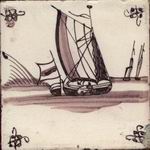
|
Maritime
motifs like ships,
fish and other
sea animals were very common. For a seafaring nation with great
merchant, warship and fishing fleets, this seems natural (Fig.:
fishing trawler; purple; corner motif: spider; Delft or Rotterdam, 18th
c.; 13,0 x 13,0 x 0,8 cm).
|
You can already find
illustrations
of ships towards the end of the 16th century in which the
central motif is frequently surrounded by typical borders of that period (1570
- 1600: the Italian circle band and the Moorish diamond; 1620 - 1650: the
accolade). These early rare illustrations are polychrome. Subsequently, up to the mid-18th century, the tiles have no borders around the central motif and are now
painted in blue. Later they were also painted in purple. Typical are the corner motifs
of the ox-head and
spider. Starting from the late 18th century, the blue- or purple-coloured ships are
mostly painted in a double circle; the spider as corner motif prevailed. In all
of these periods, all kinds of contemporary sailing ships (war and cargo
ships), but also fishing boats and the smallest punts, were illustrated.
Back
to top
| Polychrome as
well as blue illustrations of fish
were already manufactured in the frist half of the 17th century.
However, most fish tiles date from the 2nd half of
the 17th century to the 1st half of the 18th century (Fig.:
dolphin; blue; corner motif: ox-head; 18th c.; 13,0 x 13,0 x 0,8 cm). |
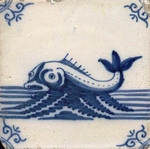
|
These
tiles
have no border around the central motif, are painted in blue and the ox-head or the
spider are used as corner motifs.
|
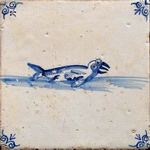
|
The fish
swim partly gracefully and
partly terrifyingly on waves that are represented schematicly. Other sea animals were
painted in the same way, especially crabs, snails, frogs, seals and crocodiles (Fig.:
walrus; blue; corner motif: ox-head; 2nd half 17th c.; 12,7 x 12,7 x 1,1 cm;
rare). |
|
|
Back
to top
Tiles depicting children's
games are rare in the first half of the 17th century (starting from 1620 on).
These early tiles have baluster or accolade borders. Corner motifs are the lily,
the (large)
ox-head, the volute and the fretwork. However, popular motifs between the 2nd half of the
17th century and the 1st half of the 18th century have no border, and
the spider and the (smaller) ox-head as corner motifs, or no corner
decoration (Fig. above: children in fancy dress on Pancake
Day; 12,4 x 12,4 x 1,0 cm;
below: children making music with
drum and flute; 12,5 x 12,5 x 0,9 cm; both blue; corner motif: spider; 1660 - 1700).
|
 |
Frequently illustrated are:
skipping, playing with a ball, badminton, playing marbles, swinging,
kite flying, slingshots, hobby-horses, paper windmills as well as golf, boxing and
swimming. Altogether more than 90 different games can be distinguished. |
Back
to top
As charming as children's
game tiles are motifs with putti and
angels, most of which date from the 17th and
18th centuries. Typical are single figures in the centre of the tile. They
resamble Baroque angles.
| They
are shown in various poses, holding equipment such as bow
and arrow, or torches, but also toys, musical instruments, and many other
things (Fig.: seated angel
with goblet; blue; corner motif: ox-head; 1660 - 1700; 12,9 x 12,9 x 1,0
cm). |
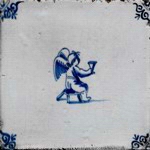
|
The typical angel tile is
painted in blue. Starting from the 2nd half of the 17th century they are decorated
with spider or ox-head corner motifs;
frequently they have no corner decoration. Less
commonly, they are polychrome and sometimes have an ornamental
background.
Back
to top
An outstanding group of
tiles are those with soldiers,
which were surely inspired by the long war of
independence against Spain. The polychrome tiles from 1590 to
1625 and the early blue motifs of the 17th century (1620 - 1700) are especially
beautiful.
|

|
Most soldier motifs from this period were
copied from the engravings of Jacob de Gheyn, who
at the end of the 16th century was asked by
Earl Johann VII of Nassau-Siegen to write a drill book
for soldiers ("Wapenhandelinghe", 1607).
Therefore you find impressive and
excellently painted illustrations of warriors, especially musketeers
and pikemen, on early tiles (Fig.:
musketeer with morion, in his hands a gun ready to fire, at the hip
a rapier; blue;
corner motif: lily; possibly Delft, 1625 - 1660; 13,3 x 13,3 x 1,2 cm).
|
Soldier tiles of
the 18th and 19th centuries, however, were more simply painted.
The early polychrome motifs (up to 1625)
are surrounded by the Italian circle band or a triple circle, then
the corners are decorated with the quarter
rosette in reserve, or the Moorish diamond, then a Moorish palmette (also called "cogwheel")
fills the corners.
Starting from approximately 1620 until 1650
blue tiles have often baluster or accolade borders.
Prevaling
corner motifs are the French lily, the leaf and the ox-head. As a rule,
later tiles with soldier motifs have no borders, but the
lily and the ox-head corner motifs continued to be used.
During all periods in which
soldier tiles were produced, they were pictured with sabres, rifles,
pikes or spears, but also with flags and musical instruments.
Back
to top
| Of course, horsemen
must also be mentioned (Fig.:
horseman on a rearing horse wearing a hat; blue; corner motif: ox-head;
probably Middelburg, 2nd half of the 17th c.; 12,8 x
12,8 x 1,1 cm). Exceptionally
beautiful tiles were painted from 1700 to 1750 in blue or purple. They
are known as "large rider".
Similarly painted tiles are again found in the late 19th century. |
|
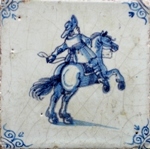 |
Horsemen
are depicted on
galloping, jumping, rearing or even falling horses with guns, pistols, sabres,
trumpets, flags and other types of equipment.
Back
to top
The more common motifs, starting
in 1620, are painted in blue. The ox-head in
its original and modified forms is as a corner motif predominantly used as are the leaf,
lily, volute and fretwork (fig.:
lawyer in his robe with a rolled document; blue; corner motif: ox-head;
1660 - 1680, 12,7 x 12,7 x 0,9 cm).
Back
to top
| Frequently are illustrated
all kinds of salesmen and saleswomen, craftsmen of different guilds, fishermen,
farmers, hunters and above all shepherds,
but also clerymen or lawyers (Fig.:
shepherdess on landscape with two sheep in the background; blue; corner motif:
spider; perhaps Friesland, 18th c.; 13,0 x 13,0 x 0,8 cm). |

|
Furthermore you find musicians,
artistes, acrobats, clowns, beggars as well as men and women in their contemporary
dress.
|
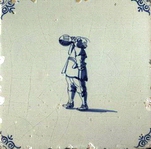
|
|
Briefly: scenes from everyday
situations are as well illustrated as the hustle and bustle in the
streets and pubs, untill to pictures of smoking, drinking and dancing people (Fig.:
drinking man; blue; corner motif: ox-head; 1640 - 1670; 12,6 x 12,6 x 1,1
cm). |
Dutch tile painters even didn't shrink back from illustrating
urinating,
vomitting and finally shiting men.
|
Such motifs were common in those
days and can also found in Rembrandt's etchings from the 1st half
of the 17th century. They served the purpose to warn
the middle class about human
immorality,
so-called pictures of the "lokker-room society" (Fig.:
vomitting drunken man hold by his wife; corner motif: spider; 1660 - 1690; 13,0 x
13,0 x 1,0 cm;
rare).
|
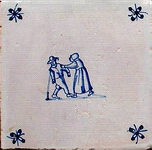
|
Back
to top
Chinese
Motifs may not be
unmentioned, for those the in the first half of the 17th century to
Europe imported Chinese porcelain was used as model. The Chinese porcelain
painting, which characterised the illustration of the Dutch tiles until the 20th
century, was in a way a heavensent opportunity for the tile painters.
| That
influence reflects as well in the arrangement of the corner motif, namely
the fretwork according to "meander"-patterns,
as the illustration of birds, insects and flowers, so called Chinese garden (see
fig.: Chinese garden in double circle with
"aigrette" = plume; blue; corner
motif: three dot; probably Rotterdam or Haarlem, 1620 -
1650;
13,0 x 13,0 x 1,1 cm), |
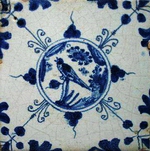
|
|
or
finally Chinese sceneries of the daily life or persons in traditional dress and
pose.
Back
to top
After all the illustration of all kinds of animals (look
for more early produced animal tiles under the link "Introduction":
archway-tile with a fox, the polychrome motif in Moorish diamond decorated
with a hare and the deer in accolade border and fretwork corner motif; the link "Production Process": goat in jagged
diamond; the links "Corner motifs": "Rotterdamse
kroontegel" and the link "Determination of Age": both with a fox
as central motif)
were especially very popular.
|
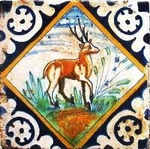
|
From 1570 to the first quarter of the 17th
century they are polychrome. The central motif is either painted in a square (the
Moorish diamond) with the palmette ("cogwheel") corner motif or in a wide circle
(the Italian circle band) with the quarter rosette as corner motif (Fig.:
deer in a diamond with palmette corner motif in reserve; polychrome; 1580 - 1625,
approx. 1610; 13,2 x 13,2 x 1,5 cm). |
Starting
from 1620 the tiles are mainly painted in blue; the baluster- and accolade-borders are
typical. The corner motifs are
varying
between fretwork, lily, ox-head or leaf.
| Pictured are not only
exotic or zoo-animals, for instance elephants, lions, panthers, bears, camels
and monkeys (Fig.: big cat in scalloped
border; blue; corner motif: fretwork;
Rotterdam, 1620 - 1660;
13,4 x 13,4 x 1,5 cm),
or home animals of the forest, as squirrels, and above all of the hunt
as deers, foxes, hares and wild pigs, |
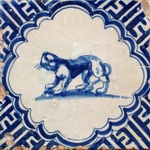
|
|
but also domestic animals as cows, goats, pigs,
sheep, horses, cats and dogs (altogether called "Springertjes").
Back
to top
llustrated are further various kinds of birds,
namely parrots, peacocks, owls, raptors and song-birds, up to flightless
birds, as ostriches,
|

|
and even swans, dugs, goose as well as
roosters and hens (Fig.:
eagle; blue; corner motif: bloom; 1635 - 1660;
13,0 x 13,0 x 1,2 cm;
as well an early picture of a bird from 1590 - 1625: magpie in Italian circle
band; polychrome; corner motif: quarter rosette painted in reserve
technique; which you can find under
the link "Corner motif"). |
Finally you find pictures of insects, mostly
butterfly, grasshopper and dragonfly,
|
|
and now and then also
caterpillars, namely often on flowers or plants (Fig.:
butterfly flying over a flower; in a wide circle; polychrome; corner motif:
fretwork; Harlingen, 1630 - 1650;
13,0 x 13,0 x 1,2 cm; rare). |
|

|
Back
to top
As pattern were used the illustrations in
zoological books of the 16th and 17th century (e.g. the "Animalium
quadrupedum", c. 1612, with illustrations of Adrian Collaert and the "Historia
naturalis", c. 1650, with copper engravings of Matthäus Merian) or wood
engravings of Albrecht Dürer and etchings of Nicolas Berchem.
In contrast to
the illustrations until 1660, the animals painted in the 2nd half of the 17th
century are smaller, respectively very small, the colour is still blue. As
corner motifs are used the ox-head (in its smaller type) and the spider, partly the
tiles doesn't have any corner decoration.
| Since the
beginning of the 18th century to the 19th century the animal tiles are painted
mostly in a large threefold circle. Predominante is now the
spider corner motif (Fig.:
hare in a threefold circle; blue; corner motif: spider; approx. 1850;
12,8 x 12,8 x 0,8 cm). |
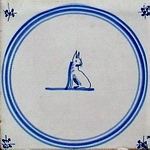
|
|
Back
to top
Beneath more or less realistic
themes phantastic motifs were popular, too. Illustrations
on waves riding sea
creatures, half human beings half fish, as well as sea
monsters, half fish half mammal or even half dragon reflected
stories of well travelled sailors during the 17th and 18th century. Partly
the paintings also had a mythological background:
|

|
Typical therefore were for example
illustrations of Poseidon (Neptun), the god of the sea, with his trident, or of his son
Triton with the shell-horn on his lips, of Amor with bow and arrow, as well as
of Venus on a shell (Fig.: Neptun; blue; corner motif:
ox-head; 1660 - 1700; 12,5 x 12,5 x 1,0 cm). |
Motifs between
1600 and 1625 were polychrome and did cover nearly the total tile. Patterns were
again for instance etchings of Jacob de Gheyn.
| The illustrations from 1640 on,
whereby you can find pictures of sea creatures and sea monsters mostly in the
2nd
half of the 17th century and still in a similar way painted from 1780
untill 1830, were usually blue and had spider or ox-head corner motifs (Fig.:
dragon; blue; corner motif: ox-head; 1660 - 1680; 12,6 x 12,6 x 0,9 cm). |

|
|
They swim (comparable to ship- and fish-illustrations from
the same periode) on stylized waves, which look sometimes like a
carpet.
Back
to top
Scenes of the Greek or Roman mythology
belong to the same category of phantastic illustrations. Mythological tiles were
produced mainly in the 17th century, whereby for the early polychrome exemplars
the etchings of Jan Muller were copied. However, the form of the central motif
and the chosen corner motifs look similar to those of sea creatures.
|
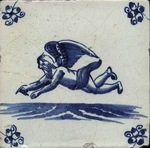
|
|
Not only well known
scenes from the myth were painted, e.g. godfather Zeus in the shape of a bull carrying
Europa across the Bosporus,
but also scenes from the Greek epic of the heroes (Fig.:
Daedalus; blue;
corner motif: spider; 1640 -
1680; 12,9 x 12,9 x 1,0 cm). |
Furthermore were
illustrated mermaids, nymphs and satyrs.
Back
to top
The earlist Dutch tile
motifs
are
ornamental designs, which were painted already in the late 16th century
(starting
from 1570) and the early 17th centrury. In that period they were polychrome
(see three
further examples of very early ornament tiles under the links "Introdction",
"Corner motifs" and "Determination of Age").
The patterns followed the Spanish/Moorish tradition of the 16th century and
showed the typical Antwerp ornament-motifs.
Although from 1600 on the decoration with objects and
figures came to the for, in the 17th, 18th and 19th century tiles with ornamental
patterns in various
kinds can be found too.
| They often adopted the decorative
elements of the actual epoch (Baroque, Louis XIV style, Rokoko/Louis XV
style, Empire/Neo-classicism) and were painted
- starting from mid-17th century - mostly in blue or purple (Fig.:
ornamental tile; purple; 1770 - 1930, whereby this sample was produced
approx. at the end of the 18th c.; 13,1 x 13,1 x 0,7 cm). |

|
|
The specimens of the 19th century
sometimes look like wallpaper designs. The reason was probably the increasing
demand for painted wallpaper to decorate rooms, to which tiles more and more did
compete with.
Back
to top
Ornament tiles should not mixed up with cartouche
designs, whose paterns look quite similar, and inanimate
designs, showing objects unattended by other items.
|
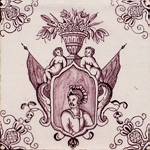
|
|
Such motifs
appeared predominant during the 18th and 19th century. The painting was mostly
kept in purple. (Fig.:
vase on cartouche with portrait of a man and two amoretti each holding a
flag; purple; corner motif: quarter rosette; Rotterdam, 1720 - 1770; 12,9
x 12,9 x 0,7 cm, rare). |
Back
to top
A special form of illustration developed strengthened in the
18th and 19th century. Those are so-called tile pictures, which show a
figurative composition by itself covering more than one tile. Illustrated were
horses, cows, cats and dogs, which were used very often for fire-places and wall decorations in farmhouses and
which consisted mostly of four or six tiles.
Very
popular were also maritime tile pictures (showing single or a couple of ships as well
as naval battles), which were partly painted over five to five or five to six
tiles. Frequently those "tableaus" decorated the houses of
sailors.
|

|
|
Really every kind of motif can be found:
biblical scenes (Fig.: Joseph
flees into Egypt, with Jesus and his mother Mary, Matthew II.14.;
purple; Utrecht, 2nd half 19th c.; composed from
12 tiles, each tile 12,8 x 12,8 x 1,0 cm) and mythological
topics, landscapes with buildings as well as
war-scenes or pictures from farmer's life, eyeryday situations with
illustrations of single persons or groups, e.g. craftsmen and children.
|
In addition to that I can mention birdcages with different
birds, especially with the yellow canary (look
for such a tile picture from the 2nd half of the 19th c. under "Introduction"),
flower-arrangements, Chinese decors and furthermore large ornaments. Especially famous are finally portraits of
riders, which
showed mostly members of the Dutch Royal Family.
Back
to top
Pillars and festoons also fall under the category of tile pictures.
They were produced predominantly in the 18th
and 19th century, painted in blue or purple.
Pillars are tile pictures formed by 13,
sometimes by 12 tiles, layed in a vertical row. Now and then pillars are two
tiles wide, so-called double pillar. The tiles show flower or leaf tendrils,
decorated with birds or putti, why such tile pictures also are named tendril.
| Tile pillars were primarily fixed on
either sides of fireplaces. Sometimes they were used as pilasters to
decorate each side of a doorway, which applies especially for North
Germany (Fig.: part of a tendril:
grapevine with putto and bunch of grapes; blue; perhaps Makkum; 1700 -
1780; each
tile 12,9 x 12,9 x 0,9 cm; rare). Festoons,
i.e. flower garlands, partly decorated with fruits, birds or other
animals, and often having a bow at the top, are similar to pillars.
|
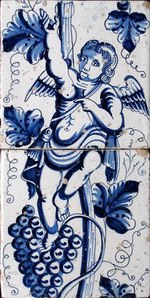
|
|
They
are formed by 4, 6 or 12 vertical placed tiles, and were mainly used as
a visual partition between two
larger
fields of tiles.
Back
to top
Final it should be mention too that
in every period special tiles were burned, which have been used round tiled
walls or tile pictures as borders,
plinths or friezes. The patern does mostly
correspond to the paintings, ornamental decors and even the motifs of the hereby
framed tiles. This causes the great variety of "border tiles".
You find not only border tiles which design is covering a singel tile,
creating an alternating patern by placing the tiles alongside one another,
but also tiles which have a design across two or more tiles,
creating an ongoing picture (predominant for frieze tiles).
|

|
The early border tiles (1570 - 1650)
are according to the early tiles motifs polychrome (Fig.:
two border tiles with marigolds and winged leafs; polychrome;
1610 - 1640; 6,8 x 13,8 x 1,6 cm). |
The later samples (since 1620) are
as expected blue and since the 18th century also purple. Afterwards they are
now and than again polychrome. The typical size of border tiles is 6,5 x 13 cm
(so called halves; "halfjes"). Plinth or frieze tiles (the first were
used as base of tiled walls and the second to complete their top edge) are
matching with 13 x 13 cm to the
typical size of "motif tiles". Also square are the half-sized
border-corner tiles (6,5 x 6,5 cm) to form crosswise a complete border design.
Back
to top
In other words: Before the
collectors eyes spreads out a never endig choise of paterns and themes, in which
the pictured scenes are giving an impression of the Good Old Days.

